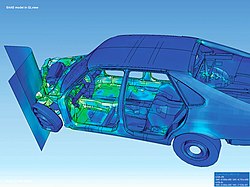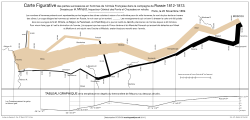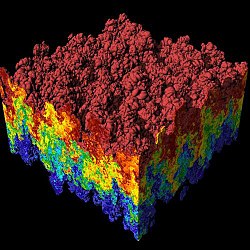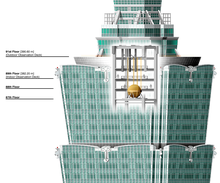From Wikipedia, the free encyclopedia
Urban resilience has conventionally been defined as the
"measurable ability of any urban system, with its inhabitants, to
maintain continuity through all shocks and stresses, while positively
adapting and transforming towards sustainability".
Therefore, a resilient city is one that assesses, plans and acts to
prepare for and respond to hazards - natural and human-made, sudden and
slow-onset, expected and unexpected. Resilient Cities are better
positioned to protect and enhance people's lives, secure development
gains, foster an investible environment, and drive positive change. Academic discussion of urban resilience has focused primarily on three distinct threats; climate change, natural disasters, and terrorism.
Resilience to these threats has been discussed in the context of
non-physical, as well as, physical aspects of urban planning and design. Accordingly, resilience strategies have tended to be conceived of in terms of counter-terrorism, other disasters (earthquakes, wildfires, tsunamis, coastal flooding, solar flares, etc.), and infrastructure adoption of sustainable energy.
More recently, there has been an increasing attention to genealogies of urban resilience and the capability of urban systems to adapt to changing conditions. This branch of resilience theory builds on a notion of cities as highly complex adaptive systems. The implication of this insight is to move urban planning
away from conventional approaches based in geometric plans to an
approach informed by network science that involves less interference in
the functioning of cities. Network science provides a way of linking
city size to the forms of networks that are likely to enable cities to
function in different ways. It can further provide insights into the
potential effectiveness of various urban policies.
This requires a better understanding of the types of practices and
tools that contribute to building urban resilience. Genealogical
approaches explore the evolution of these practices over time, including
the values and power relations underpinning them.
Building resilience in cities relies on investment decisions that
prioritize spending on activities that offer alternatives, which
perform well in different scenarios. Such decisions need to take into
account future risks and uncertainties. Because risk can never be fully
eliminated, emergency and disaster planning is crucial. Disaster risk management frameworks, for example, offer practical opportunities for enhancing resilience.
More than half of the world's human population has lived in cities since 2007, and urbanization is calculated to rise to 80% by 2050.
This means that the major resilience challenges of our era, such as
poverty reduction, natural hazards and climate change, environmental
sustainability, and social inclusion, will be won or lost in cities.
Mass density of people makes them especially vulnerable both to the
impacts of acute disasters and the slow, creeping effects of the
changing climate; all making resilience planning critically important.
At the same time, growing urbanization over the past century has been
associated with a considerable increase in urban sprawl.
Resilience efforts address how individuals, communities and business
not only cope on the face of multiple shocks and stresses, but also
exploit opportunities for transformational development.
As one way of addressing disaster risk in urban areas, national
and local governments, often supported by international funding
agencies, engage in resettlement. This can be preventative, or occur
after a disaster. While this reduces people's exposure to hazards, it
can also lead to other problems, which can leave people more vulnerable
or worse off than they were before. Resettlement needs to be understood
as part of long-term sustainable development, not just as a means for
disaster risk reduction.
Sustainable Development Goal 11
In September 2015, world leaders adopted the 17 Sustainable Development Goals (SDGs) as part of the 2030 Agenda for Sustainable Development. The goals, which build on and replace the Millennium Development Goals,
officially came into force on 1 January 2016 and are expected to be
achieved within the next 15 years. While the SDGs are not legally
binding, governments are expected to take ownership and establish
national frameworks for their achievement. Countries also have the
primary responsibility for follow-up and review of progress based on
quality, accessible and timely data collection. National reviews will
feed into regional reviews, which in turn will inform a review at the
global level.
UN-Habitat's City Resilience Profiling Tool (CRPT)
As
the UN Agency for Human Settlements, UN-Habitat is working to support
local governments and their stakeholders build urban resilience through
the City Resilience Profiling Tool (CRPT). When applied, UN-Habitat's
holistic approach to increasing resiliency results in local governments
that are better able to ensure the wellbeing of citizens, protect
development gains and maintain functionality in the face of hazards. The
tool developed by UN-Habitat to support local governments achieve
resilience is the City Resilience Profiling Tool. The Tool follows
various stages and UN-Habitat supports cities to maximize the impact of
CRPT implementation.
Getting started
Local governments and UN-Habitat connect to evaluate the needs,
opportunities and context of the city and evaluate the possibility of
implementing the tool in their city. WIth our local government partners,
we consider the stakeholders that need to be involved in
implementation, including civil society organizations, national
governments, the private sectors, among others.
Engagement
By signing an agreement with a UN agency, the local government is better
able to work with the necessary stakeholders to plan-out risk and
built-in resilience across the city.
Diagnosis
The CRPT provides a framework for cities to collect the right data about
the city that enables them to evaluate their resilience and identify
potential vulnerability in the urban system. Diagnosis through data
covers all elements of the urban system, and considers all potential
hazards and stakeholders.
Resilience Actions
Understanding of the entire urban system fuels effective action. The
main output of the CRPT is a unique Resilience Action Plan (RAP) for
each engaged city. The RAP sets out short-, medium- and long-term
strategies based on the diagnosis and actions are prioritised, assigned
interdepartmentally, and integrated into existing government policies
and plans. The process is iterative and once resilience actions have
been implemented, local governments monitor impact through the tool,
which recalibrates to identify next steps.
Taking it further
Resilience actions require the buy-in of all stakeholders and, in many
cases, additional funding. With a detailed diagnostic, local governments
can leverage the support of national governments, donors and other
international organizations to work towards sustainable urban development.
To date, this approach is currently being adapted in Barcelona
(Spain), Asuncion (Paraguay), Maputo (Mozambique), Port Vila (Vanuatu),
Bristol (United Kingdom), Lisbon (Portugal), Yakutsk (Russia), and Dakar
(Senegal). The biennial publication, Trends in Urban Resilience, also
produced by UN-Habitat is tracking the most recent efforts to build
urban resilience as well as the actors behind these actions and a number
of case studies.
Medellin Collaboration for Urban Resilience
The
Medellin Collaboration for Urban Resilience (MCUR) was launched at the
7th session of the World Urban Forum in Medellín, Colombia in 2014. As a
pioneering partnerships platforms, it gathers the most prominent actors
committed to building resilience globally, including UNISDR, The World
Bank Group, Global Facility for Disaster Reduction and Recovery,
Inter-American Development Bank, Rockefeller Foundation, 100 Resilient
Cities, C40, ICLEI and Cities Alliance, and it is chaired by UN-Habitat.
MCUR aims to jointly collaborate on strengthening the resilience
of all cities and human settlements around the world by supporting
local, regional and national governments. It addresses its activity by
providing knowledge and research, facilitating access to local-level
finance and raising global awareness on urban resilience through policy
advocacy and adaptation diplomacy efforts. Its work is devoted to
achieving the main international development agendas, as it works to
achieve the mandates set out in the Sustainable Development Goals, the
New Urban Agenda, the Paris Agreement on Climate Change and the Sendai Framework for Disaster Risk Reduction.
The Medellin Collaboration conceived a platform to help local
governments and other municipal professionals understand the primary
utility of the vast array of tools and diagnostics designed to assess,
measure, monitor and improve city-level resilience. For example, some
tools are intended as rapid assessments to establish a general
understanding and baseline of a city's resilience and can be
self-deployed, while others are intended as a means to identify and
prioritise areas for investment. The Collaboration has produced a
guidebook to illustrate how cities are responding to current and future
challenges by thinking strategically about design, planning, and
management for building resilience. Currently, it is working in a
collaborative model in six pilot cities: Accra, Bogotá, Jakarta, Maputo,
Mexico City and New York City.
100 Resilient Cities and the City Resilience Index (CRI)
"Urban
Resilience is the capacity of individuals, communities, institutions,
businesses, and systems within a city to survive, adapt, and grow no
matter what kinds of chronic stresses and acute shocks they experience." Rockefeller Foundation, 100 Resilient Cities.
A central program contributing to the achievement of SDG 11
is the Rockefeller Foundation's 100 Resilient Cities. In December 2013,
The Rockefeller Foundation launched the 100 Resilient Cities
initiative, which is dedicated to promoting urban resilience, defined as
"the capacity of individuals, communities, institutions, businesses,
and systems within a city to survive, adapt, and grow no matter what
kinds of chronic stresses and acute shocks they experience".
The related resilience framework is multidimensional in nature,
incorporating the four core dimensions of leadership and strategy,
health and well-being, economy and society and infrastructure and
environment. Each dimension is defined by three individual "drivers"
which reflect the actions cities can take to improve their resilience.
While the vagueness of the term "resilience" has enabled
innovative multi-disciplinary collaboration, it has also made it
difficult to operationalize or to develop generalizable metrics. To
overcome this challenge, the professional services firm Arup has helped the Rockefeller Foundation develop the City Resilience Index
based on extensive stakeholder consultation across a range of cities
globally. The index is intended to serve as a planning and
decision-making tool to help guide urban investments toward results that
facilitate sustainable urban growth
and the well-being of citizens. The hope is that city officials will
utilize the tool to identify areas of improvement, systemic weaknesses
and opportunities for mitigating risk. Its generalizable format also
allows cities to learn from each other.
The index is a holistic articulation of urban resilience premised on the finding that there are 12 universal factors or drivers
that contribute to city resilience. What varies is their relative
importance. The factors are organized into the four core dimensions of
the urban resilience framework:
Leadership and strategy
- Effective leadership and management
- Empowered stakeholders
- Integrated development planning
Health and well-being
- Minimal human vulnerability
- Diverse livelihoods and employment
- Effective safeguards to human health and life
Economy and society
- Sustainable economy
- Comprehensive security and rule of law
- Collective identity and community support
Infrastructure and environment
- Reduced exposure and fragility
- Effective provision of critical services
- Reliable mobility and communications
A total of 100 cities across six continents have signed up for the Rockefeller Center's urban resilience challenge.
All 100 cities have developed individual City Resilience Strategies
with technical support from a Chief Resilience Officer (CRO). The CRO
ideally reports directly to the city's chief executive and helps
coordinate all the resilience efforts in a single city.
Medellin in Colombia qualified for the urban resilience challenge in 2013. In 2016, it won the Lee Kuan Yew World City Prize.
Digital technology, open data and governance for urban resilience
A
core factor enabling progress on all other dimensions of urban
resilience is urban governance. Sustainable, resilient and inclusive
cities are often the outcome of good governance that encompasses
effective leadership, inclusive citizen participation and efficient
financing among other things. To this end, public officials increasingly
have access to public data, enabling evidence-based decision making. Open data
is also increasingly transforming the way local governments share
information with citizens, deliver services and monitor performance. It
enables simultaneously increased public access to information and more
direct citizen involvement in decision-making.
As part of their resilience strategies, city governments are
increasingly relying on digital technology as part of a city's
infrastructure and service delivery systems. On the one hand, reliance
on technologies and electronic service delivery has made cities more
vulnerable to hacking and cyberattacks.
At the same time, information technologies have often had a positive
transformative impact by supporting innovation and promoting
efficiencies in urban infrastructure, thus leading to lower-cost city
services. The deployment of new technologies in the initial construction
of infrastructure have in some cases even allowed urban economies to
leapfrog stages of development. An unintended outcome of the growing digitalization of cities is the emergence of a digital divide,
which can exacerbate inequality between well-connected affluent
neighborhoods and business districts, on the one hand, and
under-serviced and under-connected low-income neighborhoods, on the
other. In response, a number of cities have introduced digital inclusion programs to ensure that all citizens have the necessary tools to thrive in an increasingly digitalized world.
Climate change and urban resilience
The urban impacts of climate change vary widely across geographical and developmental scales. A recent study of 616 cities (home to 1.7 billion people, with a combined GDP of US$35
trillion, half of the world's total economic output), found that floods
endanger more city residents than any other natural peril, followed by
earthquakes and storms. Below is an attempt to define and discuss the
challenges of heat waves, droughts and flooding. Resilience-boosting strategies will be introduced and outlined.
Heat waves and droughts
Heat waves are becoming increasingly prevalent as the global climate changes. The 1980 United States heat wave and drought killed 10,000 people. In 1988 a similar heat wave and drought killed 17,000 American citizens.
In August 2003 the UK saw record breaking summer temperatures with
average temperatures persistently rising above 32 °C. Nearly 3,000
deaths were contributed to the heat wave in the UK during this period,
with an increase of 42% in London alone. This heat wave claimed more than 40,000 lives across Europe.
Research indicates that by 2040 over 50% of summers will be warmer
than 2003 and by 2100 those same summer temperatures will be considered
cool. The 2010 northern hemisphere summer heat wave was also disastrous, with nearly 5,000 deaths occurring in Moscow.
In addition to deaths, these heat waves also cause other significant
problems. Extended periods of heat and droughts also cause widespread
crop losses, spikes in electricity demand, forest fires, air pollution and reduced biodiversity in vital land and marine ecosystems.
Agricultural losses from heat and drought might not occur directly
within the urban area, but it certainly affects the lives of urban
dwellers. Crop supply shortages can lead to spikes in food prices, food
scarcity, civic unrest and even starvation
in extreme cases. In terms of the direct fatalities from these heat
waves and droughts, they are statistically concentrated in urban areas, and this is not just in line with increased population densities, but is due to social factors and the urban heat island effect.
Urban heat islands
Urban heat island (UHI) refers to the presence of an inner-city microclimate
in which temperatures are comparatively higher than in the rural
surroundings. Recent studies have shown that summer daytime
temperatures can reach up to 10 °C hotter in a city centre than in rural
areas and between 5–6 °C warmer at night. The causes of UHI are no mystery, and are mostly based on simple energy balances and geometrics. The materials commonly found in urban areas (concrete and asphalt) absorb
and store heat energy much more effectively than the surrounding
natural environment. The black colouring of asphalt surfaces (roads,
parking lots and highways) is able to absorb significantly more electromagnetic radiation,
further encouraging the rapid and effective capture and storage of heat
throughout the day. Geometrics come into play as well, as tall
buildings provide large surfaces that both absorb and reflect sunlight
and its heat energy onto other absorbent surfaces. These tall buildings
also block the wind, which limits convective cooling. The sheer size of the buildings also blocks surface heat from naturally radiating back into the cool sky at night.
These factors, combined with the heat generated from vehicles, air
conditioners and industry ensure that cities create, absorb and hold
heat very effectively.
Social factors for heat vulnerability
The
physical causes of heat waves and droughts and the exacerbation of the
UHI effect are only part of the equation in terms of fatalities; social
factors play a role as well. Statistically, senior citizens represent
the majority of heat (and cold) related deaths within urban areas
and this is often due to social isolation. In rural areas, seniors are
more likely to live with family or in care homes, whereas in cities
they are often concentrated in subsidised apartment buildings and in
many cases have little to no contact with the outside world.
Like other urban dwellers with little or no income, most urban seniors
are unlikely to own an air conditioner. This combination of factors
leads to thousands of tragic deaths every season, and incidences are
increasing each year.
Adapting for heat and drought resilience
Greening, reflecting and whitening urban spaces
Greening
urban spaces is among the most frequently mentioned strategies to
address heat effects. The idea is to increase the amount of natural
cover within the city. This cover can be made up of grasses, bushes,
trees, vines, water, rock gardens; any natural material. Covering as
much surface as possible with green space will both reduce the total
quantity of thermally absorbent artificial material, but the shading
effect will reduce the amount of light and heat that reaches the
concrete and asphalt that cannot be replaced by greenery.
Trees are among the most effective greening tool within urban
environments because of their coverage/footprint ratio. Trees require a
very small physical area for planting, but when mature, they provide a
much larger coverage area. This both absorbs solar energy for photosynthesis
(improving air quality and mitigating global warming), reducing the
amount of energy being trapped and held within artificial surfaces, but
also casts much-needed shade on the city and its inhabitants. Shade
itself does not lower the ambient air temperature, but it greatly
reduces the perceived temperature and comfort of those seeking its
refuge. A popular method of reducing UHI is simply increasing the albedo
(light reflectiveness) of urban surfaces that cannot be ‘greened’.
This is done by using reflective paints or materials where appropriate,
or white and light-coloured options where reflections would be
distracting or dangerous. Glazing can also be added to windows to
reduce the amount of heat entering buildings. Green roofs
are also a resilience-boosting option, and have synergies with flood
resilience strategies as well. However, depaving of excess pavement has
been found to be a more effective and cost-efficient approach to
greening and flood control.
Social strategies
There
are various strategies to increase the resilience of those most
vulnerable to urban heat waves. As established, these vulnerable
citizens are primarily socially isolated seniors. Other vulnerable
groups include young children (especially those facing abject poverty or
living in informal housing), people with underlying health problems,
the infirm or disabled and the homeless. Accurate and early prediction
of heat waves is of fundamental importance, as it gives time for the
government to issue extreme heat alerts. Urban areas must prepare and
be ready to implement heat-wave emergency response initiatives.
Seasonal campaigns aimed to educate the public on the risks associated
with heat waves will help prepare the broad community, but in response
to impending heat events more direct action is required.
Local government must quickly communicate with the groups and
institutions that work with heat-vulnerable populations. Cooling
centres should be opened in libraries, community centres and government
buildings. These centres ensure free access to air conditioning and
water. In partnership with government and non-government social
services, paramedics, police, firefighters, nurses and volunteers; the
above-mentioned groups working with vulnerable populations should carry
out regular door-to-door visits during these extreme heat scenarios.
These visits should provide risk assessment, advice, bottled water (for areas without potable tap water) and the offer of free transportation to local cooling centres.
Food and water supplies
Heat waves and droughts can reap massive damage on agricultural areas
vital to providing food staples to urban populations. Reservoirs and aquifers
quickly dry up due to increased demand on water for drinking,
industrial and agricultural purposes. The result can be shortages and
price spikes for food and with increasing frequency, shortages of
drinking water as observed with increasing severity seasonally in China and throughout most of the developing world.
From an agricultural standpoint, farmers can be required to plant more
heat and drought-resistant crops. Agricultural practices can also be
streamlined to higher levels of hydrological efficiency. Reservoirs should be expanded and new reservoirs and water towers should be constructed in areas facing critical shortages. Grander schemes of damming and redirecting rivers should also be considered if possible. For saltwater coastal cities, desalination
plants provide a possible solution to water shortages. Infrastructure
also plays a role in resilience, as in many areas aging pipelines result
in leakage and possible contamination of drinking water. In Kenya’s major cities, Nairobi and Mombasa, between 40 and 50% of drinking water is lost through leakage. In these types of cases, replacements and repairs are clearly needed.
Flooding
Flooding, either from weather events, rising sea levels
or infrastructure failures are a major cause of death, disease and
economic losses throughout the world. Climate change and rapidly
expanding urban settlements are two factors that are leading to the
increasing occurrence and severity of urban flood events, especially in
the developing world. Storm surges can affect coastal cities and are caused by low pressure weather systems, like cyclones and hurricanes.
Flash floods and river floods can affect any city within a floodplain
or with inadequate drainage infrastructure. These can be caused by
large quantities of rain or heavy rapid snow melt. With all forms of
flooding, cities are increasingly vulnerable because of the large
quantity of paved and concrete surfaces. These impermeable surfaces cause massive amounts of runoff and can quickly overwhelm the limited infrastructure of storm drains, flood canals and intentional floodplains. Many cities in the developing world simply have no infrastructure to redirect floodwaters whatsoever.
Around the world, floods kill thousands of people every year and are
responsible for billions of dollars in damages and economic losses.
Flooding, much like heat waves and droughts, can also wreak havoc on
agricultural areas, quickly destroying large amounts of crops. In
cities with poor or absent drainage infrastructure, flooding can also
lead to the contamination of drinking water sources (aquifers, wells,
inland waterways) with salt water, chemical pollution, and most
frequently, viral and bacterial contaminants.
Flood flow in urban environment
The
flood flow in urbanised areas constitutes a hazard to the population
and infrastructure. Some recent catastrophes included the inundations of
Nîmes (France) in 1998 and Vaison-la-Romaine (France) in 1992, the flooding of New Orleans (USA) in 2005, the flooding in Rockhampton, Bundaberg, Brisbane during the 2010–2011 summer in Queensland (Australia). Flood flows in urban environments have been studied relatively recently despite many centuries of flood events.
Some researchers mentioned the storage effect in urban areas. Several
studies looked into the flow patterns and redistribution in streets
during storm events and the implication in terms of flood modelling.
Some research considered the criteria for safe evacuation of individuals in flooded areas. But some recent field measurements during the 2010–2011 Queensland floods
showed that any criterion solely based upon the flow velocity, water
depth or specific momentum cannot account for the hazards caused by the
velocity and water depth fluctuations. These considerations ignore further the risks associated with large debris entrained by the flow motion.
Adapting for flood resilience
Urban greening
Replacing
as many non-porous surfaces with green space as possible will create
more areas for natural ground (and plant-based) absorption of excess
water. Gaining popularity are different types of green roofs. Green roofs vary in their intensity, from very thin layers of soil or rockwool supporting a variety of low or no-maintenance mosses or sedum
species to large, deep, intensive roof gardens capable of supporting
large plants and trees but requiring regular maintenance and more
structural support.
The deeper the soil, the more rainwater it can absorb and therefore
the more potential floodwater it can prevent from reaching the ground.
One of the best strategies, if possible, is to simply create enough
space for the excess water. This involves planning or expanding areas
of parkland in or adjacent to the zone where flooding is most likely to
occur. Excess water is diverted into these areas when necessary, as in Cardiff, around the new Millennium Stadium.
Floodplain clearance is another greening strategy that fundamentally
removes structures and pavement built on floodplains and returns them to
their natural habitat which is capable of absorbing massive quantities
of water that otherwise would have flooded the built urban area.
Flood-water control
Levees
and other flood barriers are indispensable for cities on floodplains or
along rivers and coasts. In areas with lower financial and engineering
capital, there are cheaper and simpler options for flood barriers. UK
engineers are currently conducting field tests of a new technology
called the SELOC (Self-Erecting Low-Cost Barrier). The barrier itself
lies flat on the ground, and as the water rises, the SELOC floats up,
with its top edge rising with the water level. A restraint holds the
barrier in the vertical position. This simple, inexpensive flood barrier
has great potential for increasing urban resilience to flood events
and shows significant promise for developing nations with its low cost
and simple, fool-proof design. The creation or expansion of flood
canals and/or drainage basins can help direct excess water away from
critical areas
and the utilisation of innovative porous paving materials on city
streets and car parks allow for the absorption and filtration of excess
water.
During the January 2011 flood of the Brisbane River (Australia), some unique field measurements about the peak of the flood showed very substantial sediment fluxes in the Brisbane River flood plain, consistent with the murky appearance of floodwaters.
The field deployment in an inundated street of the CBD showed also some
unusual features of flood flow in an urban environment linked with some
local topographic effects.
Structural resilience
In
most developed nations, all new developments are assessed for flood
risks. The aim is to ensure flood risk is taken into account in all
stages of the planning process to avoid inappropriate development in
areas of high risk. When development is required in areas of high risk,
structures should be built to flood-resistant standards and living or
working areas should be raised well above the worst-case scenario flood
levels. For existing structures in high-risk areas, funding should be
allocated to i.e. raise the electrical wiring/sockets so any water that
enters the home can not reach the electrics. Other solutions are to raise these structures to appropriate heights or make them floating or considerations should be made to relocate or rebuild structures on higher ground. A house in Mexico Beach, Florida which survived Hurricane Michael is an example of a house built to survive tidal surge.
The pre-Incan Uru people of Lake Titicaca in Peru have lived on
floating islands made of reeds for hundreds of years. The practice began
as an innovative form of protection from competition for land by
various groups, and it continues to support the Uru homeland. The manual
technique is used to build homes resting on hand-made islands
all from simple reeds from the totora plant. Similarly, in the southern
wetlands of Iraq, the Marsh Arabs (Arab al-Ahwār) have lived for
centuries on floating islands and in arched buildings
all constructed exclusively from the local qasab reeds. Without any
nails, wood, or glass, buildings are assembled by hand as quickly as
within a day. Another aspect of these villages, called Al Tahla, is that
the built homes can also be disassembled in a day, transported, and
reassembled.
Emergency response
As with all disasters, flooding requires a specific set of disaster response plans. Various levels of contingency planning should be established, from basic medical and selective evacuation provisions involving local emergency responders
right the way up to full military disaster relief plans involving
air-based evacuations, search and rescue teams and relocation provisions
for entire urban populations. Clear lines of responsibility and chains
of command must be laid out, and tiered priority response levels should
be established to address the immediate needs of the most vulnerable
citizens first. For post-flooding repair and reconstruction sufficient
emergency funding should be set aside proactively.
Educational programs related to urban resilience
The
emergence of urban resilience as an educational topic has experienced
an unprecedented level of growth due in large part to a series of
natural disasters including the
2004 Indian Ocean earthquake and tsunami, 2005
Hurricane Katrina, the
2011 Tohoku earthquake and tsunami, and
Hurricane Sandy in 2012. Two of the more well-recognized programs are
Harvard Graduate School of Design's Master's program in Risk and Resilience, and
Tulane University's Disaster Resilience Leadership Academy. There are also several workshops available related to the U.S.
Federal Emergency Management Agency and the
Department of Homeland Security. A list of
more than 50 current graduate and undergraduate programs focusing on urban resilience has been compiled by
The Resilience Shift.










